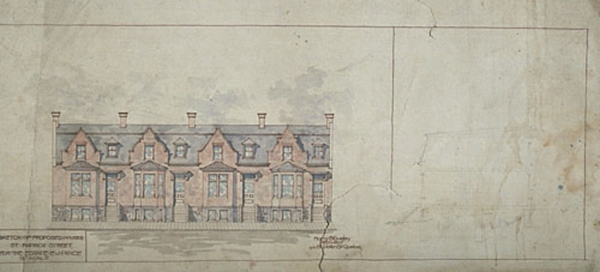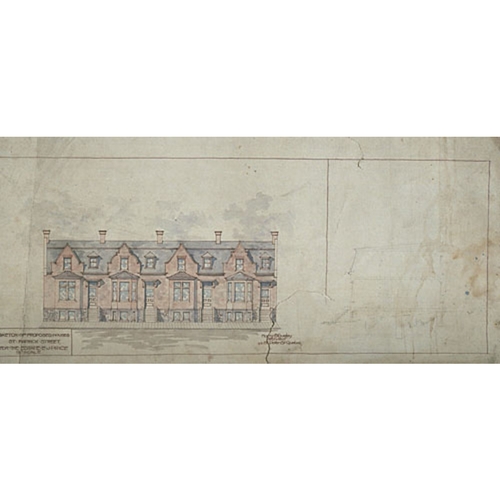
Source: Link
STAVELEY, HARRY, architect; b. 21 May 1848 at Quebec, son of Edward Staveley, an architect, and Mary Ann White; m. there 18 Oct. 1876 Barbara Black, and they had three sons and one daughter; d. there 24 July 1925.
Harry Staveley was the second member of a family dynasty who were active as architects in Quebec City from 1845 until 1960. His grandfather Christopher Staveley was an architect, engineer, and surveyor in Leicester, England. His father, Edward, emigrated in 1833 and, after working as an engineer on railway and canal building projects in Baltimore, Md, settled at Quebec in 1844. A year later he went into partnership with Frederick Hacker, an influential British architect who had trained in the London office of John Nash. When Hacker died in 1846, the firm, Hacker and Staveley, was dissolved. Edward then practised on his own before finding a new partner, Gerald George Dunlevie, a surveyor and architect who had been born around 1809 in the West Indies and died sometime after 1883; they formed Staveley and Dunlevie, a firm that lasted from 1851 until 1858. At a time when most of the Irish, British, and American architects who immigrated to Quebec – for example, men like George Browne*, Richard John Cooper, and John Cliff – promptly left to pursue work on important building projects in Montreal, Toronto, or Kingston, Edward Staveley chose to make a career for himself in the city, among the middle-class anglophones who gave him commissions for houses, villas, shops, schools, and churches. His son Harry, who became his next partner, would reap the benefits of his decision to stay.
Harry Staveley studied with Professor Frederick East at Quebec and trained as an architect in his father’s firm. In 1863 he was made a partner and it became known as Edward Staveley and Son. By the time of Edward’s death nine years later, Harry had begun the productive career that would make him the foremost “Victorian” architect in Quebec City. He was initially influenced by his father, who had adopted a blend of late neoclassicism and Italian Renaissance. The financial elite of the old capital found this image, which was made known by the model books of the American architect Minard Lafever and was widely favoured in Montreal and farther west, reassuring. Harry’s work broadened to embrace the formal repertory of historicism more fully. His many cottages, villas, and row houses show the picturesque influence of two Americans, Calvert Vaux and Samuel Sloan. This favourite architect of the anglophone middle class also borrowed stylistic features from the Second Empire. Unlike Joseph-Ferdinand Peachy*, Eugène-Étienne Taché*, Georges-Émile Tanguay, and François-Xavier Berlinguet*, who used elements of this style to re-Gallicize the urban landscape, Staveley confined himself to a rather whimsical interpretation of it, one that was inspired more by the model books of American east coast architects than by the classic French examples. His houses thus add colour to the Grande Allée and to what would become known as the old city, both of them typically French in their austerity and symmetry. He also designed a number of interesting religious buildings, in fact the only ones in the Quebec City region bearing traces of the ecclesiologist movement that Augustus Welby Northmore Pugin had launched in Great Britain [see Henry Langley*].
Of the four children born to Harry Staveley and Barbara Black, Harry Lorn and Edward Black also pursued careers in architecture. The former worked for the Montreal firm of William Tutin Thomas, but the latter entered his father’s business in 1900, and thus the Staveley name would live on in Quebec City. Indeed, Harry’s career, which had been extremely productive from 1872 until 1900 while he was working on his own, gained fresh impetus with the arrival of Edward Black. A graduate of McGill University and fully conversant with the latest trends in British architecture, Edward Black put his compositional skill to good use in Staveley and Staveley. In a milieu ossified by the apprenticeship system, the firm was thus able to move beyond the model books and to limit the growing domination of the Quebec scene by architects from Montreal, Toronto, and the United States. Along Chemin Saint-Louis and the extension of the Grande Allée, but also Chemin Sainte-Foy, Avenue des Érables, and Avenue du Parc, the new Montcalm ward became the showplace of the comfortable homes in which Edward Black excelled. The Staveleys’ reputation spread beyond the city limits, gaining them the opportunity to build real mansions. Cascade House, erected for Sir William Price at Kénogami (Jonquière), Colin Cathcart Breakey’s manor at Breakeyville, and the Hôtel Roberval (in the village of that name), which was owned by Benjamin Alexander Scott and Horace Jansen Beemer*, are fine examples of their work. The firm also tendered successfully for public buildings – fire stations, schools, and hospitals – a market that had hitherto been closed to them.
Staveley and Staveley declined after the death of Harry in 1925. Limited to engaging in “domestic” architecture by difficult economic conditions, the departure of the anglophone entrepreneurial middle class, and the staleness of his architectural idiom, Edward Black retained the name of the family firm until 1936. He retired in 1960 and, a few years later, bequeathed the Staveley family papers to the Archives Nationales du Québec. They include 1,447 drawings and constitute one of the most interesting collections of 19th- and 20th-century architectural designs in Canada.
ANQ-Q, CE301-S62, 9 févr. 1862; CE301-S66, 18 oct. 1876; Index BMS, dist. judiciaire de Québec, Metropolitan Church (Québec), 27 juill. 1925; P541. Gazette (Montreal), 19 Sept. 1969. Quebec Chronicle-Telegraph, 17 Sept. 1969. Luc Noppen et Marc Grignon, L’art de l’architecte: trois siècles de dessin d’architecture à Québec (Québec, 1983). S. F. Poulin, “L’architecture résidentielle des Staveley, 1846-1954” (mémoire de ma, univ. Laval, Québec, 1995). A. J. H. Richardson et al., Quebec City: architects, artisans and builders (Ottawa, 1984), 507-17. The storied province of Quebec; past and present, ed. W. [C. H.] Wood et al. (5v., Toronto, 1931-32), 3: 52. Who’s who and why, 1912.
Cite This Article
Luc Noppen, “STAVELEY, HARRY,” in Dictionary of Canadian Biography, vol. 15, University of Toronto/Université Laval, 2003–, accessed December 31, 2025, https://www.biographi.ca/en/bio/staveley_harry_15E.html.
The citation above shows the format for footnotes and endnotes according to the Chicago manual of style (16th edition). Information to be used in other citation formats:
| Permalink: | https://www.biographi.ca/en/bio/staveley_harry_15E.html |
| Author of Article: | Luc Noppen |
| Title of Article: | STAVELEY, HARRY |
| Publication Name: | Dictionary of Canadian Biography, vol. 15 |
| Publisher: | University of Toronto/Université Laval |
| Year of publication: | 2005 |
| Year of revision: | 2005 |
| Access Date: | December 31, 2025 |



